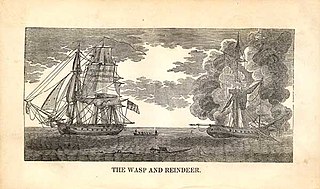
HMS Reindeer was a Royal Navy 18-gun Cruizer-class brig-sloop of the Royal Navy, built by Samuel & Daniel Brent at Rotherhithe and was launched in 1804. She was built of fir, which made for more rapid construction at the expense of durability. Reindeer fought in the Napoleonic Wars before succumbing in 1814 to the guns of USS Wasp during the War of 1812.
Nine ships of the Royal Navy have borne the name HMS Rapid:

Néréide was a Sibylle-class, 32-gun, copper-hulled frigate of the French Navy. On 22 December 1797 HMS Phoebe captured her and she was taken into British service as HMS Nereide. The French recaptured her at the Battle of Grand Port, only to lose her again when the British took Isle de France, in 1810. After the Battle of Grand Port she was in such a poor condition that she was laid up and sold for breaking up in 1816.
HMS Olympia was an Adonis-class schooner of the Royal Navy during the Napoleonic War. She was built at Bermuda using Bermudan cedar and completed in 1806. In March 1811 the French captured her, but the British recaptured her in October. During her career, she served as far afield as Buenos Aires, Île Bourbon, and Cape of Good Hope. The Admiralty sold her in 1815.
Argus was a 16-gun brig of the French Navy, launched in 1800 and broken up at Cayenne in 1807.

HMS Cossack was a Royal Navy Banterer-class post ship of a nominal 22 guns, launched in 1806 at South Shields, England. She was ordered in January 1805 as HMS Pandour and launched under that name but her name was altered to Cossack during 1806. She served throughout the Napoleonic War, but appears to have seen little action. She was broken up at Portsmouth in June 1816.

HMS Belette was an 18-gun Cruizer-class brig-sloop, built by King at Dover and launched on 21 March 1806. During the Napoleonic Wars she served with some success in the Baltic and the Caribbean. Belette was lost in the Kattegat in 1812 when she hit a rock off Læsø.
At least four vessels of the Royal Navy have borne the name HMS Belette.

HMS Haddock was a Royal Navy schooner of four 12-pounder carronades and a crew of 20. The prime contractor for the vessel was Goodrich & Co., in Bermuda, and she was launched in 1805.
On Thursday 21st inst launched off the stocks at Mr Isaac Skinner's shipyard his Majesty's Schooner "Haddock". The above schooner is said to be the completest vessel ever built in Bermuda

HMS Entreprenante, was a 10-gun cutter that the Royal Navy captured from the French in 1798. The British commissioned her in 1799 and she served during the French Revolutionary and Napoleonic Wars, participating in the Battle of Trafalgar. She has been the only ship of the Royal Navy to bear the name. She took part in several small engagements, capturing Spanish and French ships before she was sold in 1812 for breaking up.
HMS Flying Fish was the schooner Revenge, purchased in the West Indies in 1806 for the Royal Navy. She participated in a notable cutting out expedition and in 1807 in the second of the British invasions of the Río de la Plata; she was wrecked in 1808.
Jean-Michel Mahé was a French Navy officer and captain.
HMS Netley was originally the French privateer brig Déterminé, which the Royal Navy captured in 1807 and took into service. She was lost at sea on the Leeward Islands station in 1808.
The Mouche No. 2-class schooner-avisos were a class of twenty-eight 1-gun dispatch or advice boats of the French Navy, all built between 1808 and 1810. Jean Baudry designed the vessels based on the draught of Villaret. Baudry may have been the builder on the schooners launched at Bayonne.

The French schooner Impériale was a 3-gun mercantile schooner-aviso of the French Navy commissioned at Guadeloupe on 23 September 1805. The Royal Navy captured her on 24 May 1806 and named her HMS Vigilant. The Navy renamed her HMS Subtle on 20 November 1806. She wrecked at Bermuda on 20 October 1807.
HMS Subtle was a schooner that the Royal Navy reportedly captured in 1807, and purchased and registered in 1808. She served in the Caribbean, taking part in several actions, including a small debacle in 1808, and the capture of Martinique and Guadeloupe in 1809. She foundered in November 1812 with the loss of her entire crew.
HMS Skipjack was the French privateer schooner Confiance, launched in 1800 at Baltimore. The Royal Navy captured her in 1808 and took her into service. She then participated in the capture of Guadeloupe in 1810. She was paid off in 1811 and broken up in 1812.
HMS Gleaner was the mercantile ketch Gleaner, launched in 1802. She served the Royal Navy as the "hired ketch Gleaner" from 12 July 1808 until the Navy purchased her in 1809. Initially she served as a light vessel and survey vessel. From early 1811 to August 1811 she served in the Mediterranean, where she captured an Ottoman vessel. She then became a yard lighter and a light vessel again. Then in 1812 she was on the North American station where she participated in the capture of several merchant vessels. Next she returned to the Mediterranean where she captured a privateer. Finally, she served off the north coast of Spain where she was wrecked on 2 March 1814.
HMS Berbice was the Batavian Republic's schooner Serpent that HMS Heureux took possession of at Berbice in 1803 at the capitulation of the colony and that the Navy purchased in 1804. Berbice foundered in 1806 off Demerara.
HMS Tweed was launched in 1807. On the Jamaica station she captured two small privateers and several merchant vessels. On the North Sea station she captured one small privateers and several merchant vessels. She was wrecked on 5 November 1813 with the loss of more than half her crew.






